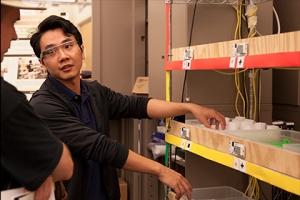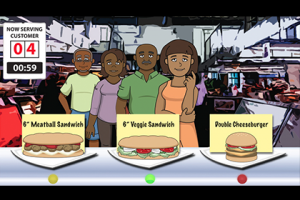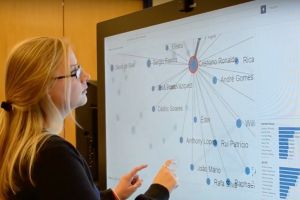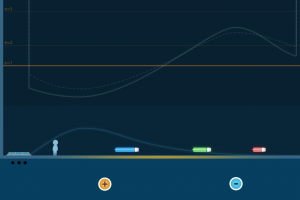|
OptoSense is a ubiquitous Imaging Surface which conforms to everyday objects, harvests energy from ambient light, and senses a variety of human activities without compromising privacy. By leveraging organic semiconductor (OSC) optoelectronics with thin & flexible form factor, large-area compatibility, and highly customizable characteristics, we aim to develop distributed imaging technologies for human activity sensing which truly “weaves” into fabrics of everyday life. |
Warehouses throughout the world distribute approximately $1 trillion in goods per year from nearly a million warehouses. Order Picking is the process of collecting items from inventory and sorting them into orders for distribution. It represents one of the main activities performed in warehouses. About 60% of the total operational costs of these warehouses is order picking. Most are still picked by hand, often using paper pick lists.  |
OrderUp! takes health-related gaming in a new direction and seeks to educate players about how to make healthy eating choices in situations nearly everyone encounters regularly in their lives. By casting players as virtual restaurant servers, OrderUp! forces players to make healthy and fast menu decisions for a group of demanding, impatient customers. OrderUp! was originally developed as a simple, casual game on Nokia N95 mobile phones.  |
Data visualization systems have predominantly been developed for WIMP-based direct manipulation interfaces. Only recently have other forms of interaction begun to appear, such as natural language or touch-based interaction, though usually operating only independently. Prior evaluations of natural language interfaces for visualization have indicated potential value in combining direct manipulation and natural language as complementary interaction techniques. Unfortunately, however, little work has been done in exploring such multimodal visualization interfaces.  |
|
"Our Driverless Futures" is a web-based interactive narrative that critically examines the ethical implications of self-driving cars. In public and scholarly discourse, self-driving cars are often positioned as safer and more efficient transportation alternatives, with one prominent debate remaining in their programming: how should they react in an inevitable fatal accident, and whose lives should they prioritize to save? However, this focus on "kill decisions" has limited the terms of discourse to utilitarian ethics and normative classifications of people. |
Informing the planning of hikes and trail walks through immersive experiences right from your screen at home. |
Alone in a strange and dark forest, you find a lantern, your sole source of light and comfort. But soon you are joined by two characters, and each makes a compelling argument as to why you should give the lantern to them. Who do you trust? You decide! This virtual reality experience places you at the penultimate moment of Cartoon Network's Emmy-award winning "Over the Garden Wall" mini-series.  |
In collaborative human-robot assembly tasks, the robot will need to identify important elements of a scene (humans, objects) and understand their behavior and interaction. Estimated skeleton and object interaction information are often used for video-based human activity recognition, but most research focuses on depth sensors. There are many more standard RGB cameras and videos in the world, but unreliability of pose/object estimations hinders their adoption in this domain. We present novel techniques for dealing with such unreliability to aid in adoption of these techniques for RGB sensors. |
|
The rise of ubiquitous technology has resulted in exponential growth in potential options for the design of interactive museum exhibits. We posit that using a framework of parental beliefs about learning and teaching for design can be useful to the HCI community when creating museum exhibits to facilitate learning. Our study builds upon Swartz and Crowley's framework of parental pedagogical approaches through analysis of 118 observations of social interactions between parents and children at museum exhibits. |
Designing a participative approach for multiple users to control their smart home.  |
Theories of Quantum Mechanics(QM) have been central to the philosophical and technological advances in physics and related fields. Some of the most important aspects of these theories are outside the bounds of human experience, predominantly explained and taught drawing on abstract mathematical formulas.  |
|
|
Our Passive Haptic Learning gloves teach the "muscle memory" of how to play piano melodies without the learner's active attention. These gloves can also help wearers recover sensation in their hands after a traumatic event, such as a partial spinal cord injury. The PHL gloves are fingerless gloves equipped with vibrators at each knuckle. As a mobile MP3 player plays each note ofa song, the gloves tap the finger that corresponds to the respective piano key. |
Our Passive Haptic Learning gloves teach the "muscle memory" of how to play piano melodies without the learner's active attention. These gloves can also help wearers recover sensation in their hands after a traumatic event, such as a partial spinal cord injury. The PHL gloves are fingerless gloves equipped with vibrators at each knuckle. As a mobile MP3 player plays each note ofa song, the gloves tap the finger that corresponds to the respective piano key. |
Previous studies have revealed that mental health patients share their social media with their clinicians during consultations. They explain what they posted or what they saw on social media or show the content using their smartphones. However, why and how patients share it has been underexplored. Therefore, we would like to learn: a) why and how they share their social media during consultations; b) how the experiences affected their therapeutic relationships; c) how technologies can better serve their needs for sharing social media with clinicians. |


